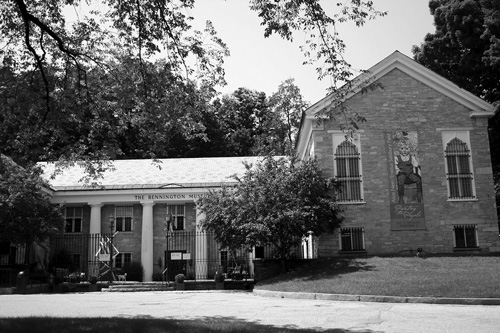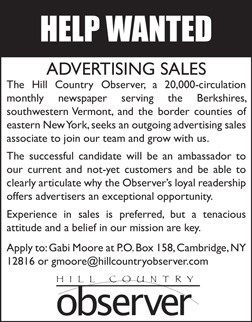Arts & Culture
Going beyond the traditional
Bennington Museum widens scope, adds taste of Vermont modernism
 By TELLY HALKIAS
By TELLY HALKIAS
Contributing writer
BENNINGTON, Vt.
Up until two years ago, the Bennington Museum mostly focused on local history, arts and culture from the 18th and 19th centuries.
Then Robert Wolterstorff was hired as the museum’s new director in the summer of 2012 after a yearlong national search. Wolterstorff, who had led the acclaimed Victoria Mansion in Portland, Maine, was seeking a new challenge, and Vermont seemed the perfect place to realize it.
“Being in Portland for 13 years, there are not many other places I could live,” Wolterstorff said. “I lived in this area for two years when I was in graduate school at Williams College and fell in love with Vermont.
“I love the landscape and the incredible cultural riches of the area,” he added. “There is a discerning audience here, and I wanted to make a contribution.”
Wolterstorff brought 20 years in arts and museum leadership to Vermont. He holds a master’s degree in art history from Williams and a master of fine arts and doctorate from Princeton University, where he wrote his dissertation on the 18th century neoclassical architect Robert Adam.
Before his tenure in Portland, he had served as director of the Ebenezer Maxwell Mansion in Philadelphia and held curatorial and research positions in the Philadelphia Museum of Art and at the Sterling and Francine Clark Art Institute, Williams College Museum of Art, and the Chapin Rare Book Library. (The latter three are all in Williamstown, Mass.)
Wolterstorff’s background served him well as he worked with the Bennington Museum’s trustees to develop a vision for its future. Although the direction was fresh, Wolterstorff said the changes he’s pursued at the museum are really a matter of unearthing what was always here in Vermont.
“The Bennington Museum’s collections are particularly strong in the 18th and 19th century, and they have the defining collection of the work of Grandma Moses,” Wolterstorff said. “We are building on those strengths. But there is also a great tradition of modernism in Vermont. In the long run, I see room to strengthen both the museum’s holdings and its exhibitions of art in Vermont in the 20th century and right up to the present.”
Bennington College connections
As part of that move to increased involvement with modernism, the museum has worked on several physical initiatives since Wolterstorff’s arrival. It also has made its existing assets more accessible to the public.
Edie Sawitsky, the chairwoman of its board of trustees, said the museum is fortunate to be in a region rich in history and tradition and has reflected that culture through its focus on historical items in its collection.
“We have the largest public collection of Grandma Moses paintings in the world,” Sawitsky said. “Our research library houses an excellent collection of Vermont historical material and genealogical and biographical data on Vermont and New England families.”
But Sawitsky said the museum’s visitors and staff are drawing a new level of energy for the ongoing transformation. The museum has updated the look and structure of its galleries, putting a new light on existing items in its collection. The result, she said, is “a new sense of color throughout the building and a feeling of welcome as you enter.”
Last year, the museum unveiled its new “Bennington Modernism” gallery, which since February has displayed Helen Frankenthaler (1928-2011), Paul Feeley (1910-1966) and Jules Olitski (1922-2007). The gallery exhibits revolving works, mostly on loan, that hearken back to the local modernist movement, especially that which had connections to Bennington College.
The museum’s curator of collections, Jamie Franklin, said that from the 1950s to the 1970s, a cohort of pioneering artists working in the Bennington area led the nation in artistic thought and innovation. They included internationally known figures such as Feeley, Frankenthaler and Olitski as well as Pat Adams, Willard Boepple, Anthony Caro, Patricia Johanson, Vincent Longo, Kenneth Noland, Dan Shapiro, David Smith and Tony Smith.
“Feeley was the head of the Bennington College art department at the time,” Franklin said. “This was an exceptionally creative group, right here in Vermont but well known nationally, and sparked by a bold willingness to experiment with their creativity and pursue the unknown.”
The works on display in the gallery include a Frankenthaler painting on loan from Bennington College’s new president, Mariko Silver.
“That painting came directly off of her wall as an offering to this gallery,” Wolterstorff said.
While leading a media tour of the galleries, he explained that one of the museum’s new initiatives is to open doors and find ways for the Bennington College students to participate in the museum for academic credit.
“In less than a year on the job, Mariko has been fantastic in her outreach throughout Vermont,” Wolterstorff said. “We’re actively studying meaningful ways to take advantage of such a high concentration of creative students right in our back yard so both museum and college can gain from it.”
New views of local history
Another gallery revamped last year is “Gilded Age Vermont.” From the mid-19th through the mid-20th century, Bennington was one of New England’s leading industrial towns and served as the commercial gateway into Vermont from New York. In 1890, it was home to more than 30 individual mills along a two-mile stretch of the Walloomsac River and boasted one of the highest per capita incomes in the nation.
The mill owners built grand, stately homes, and filled them with high-end art, furniture and other decorations. The gallery houses many such items. Drawn primarily from the museum’s permanent collection, “Gilded Age Vermont” is devoted to historical items and themes not cohesively displayed in the past.
“This gallery paints a vivid picture of innovation and prosperity from Vermont’s past,” Franklin said.
In it, he explained, Renaissance Revival furnishings and a parlor organ manufactured by the Estey Organ Co. of Brattleboro are displayed alongside Frederick MacMonnies’ portrait of May Suydam Palmer as well as a Martin Wasp, a luxury automobile made in Bennington by Karl Martin between 1920 and 1924.”
Wolterstorff added that the reinstallation of items from the museum’s permanent collection items has helped to explain the causes and effects of the wealth made possible by Vermont’s once-booming mill towns.
“What you see are trappings of wealth created by a vibrant business environment,” Wolterstorff said. “It’s important, though, to provide context. We have included several period photographs showing mill workers at their jobs.”
The photos, he said, offer a subtle socio-economic statement, as the gallery mainly houses objects purchased by the industrialist employers of those workers.
Seeking ‘creative collisions’
Perhaps no example better demonstrates the museum’s new direction than its major exhibition of 2014, “Alice Neel/Erastus Salisbury Field: Painting the People.”
The show, which opened in July and runs through Nov. 2, demonstrates how the museum’s leaders and staff are building on the strengths of the permanent collection while pursuing new perspectives.
The exhibition juxtaposes portraits by Erastus Salisbury Field (1805-1900), one of America’s best-known 19th century itinerant painters, and Alice Neel (1900-1984), one of the most celebrated American artists of the mid-20th century.
It’s a seemingly odd pairing, and that’s exactly how Franklin intended it. He said the curatorial staff is now doing things artistically that will allow the museum to better tell the story of creativity and innovation in Vermont.
Wolterstorff “has been great in supporting my curatorial ideas,” Franklin said. “The ‘Neel/Field’ show is a perfect example. Many museum directors would have dismissed it and gone with a straight Neel show. We could have done that, and it would have been great, but it wouldn’t have been as revelatory or engaging. By encouraging me to follow my instincts, Robert is allowing us to create much richer shows.”
The compare and contrast of “Neel/Field” is an example of what Wolterstorff calls “creative collisions” – in which two supposedly dissimilar subject matters are brought together to demonstrate their connection and relevance in a way that can be both instructive and pleasing.
“By introducing the works of a mid-century modern artist alongside those already in our permanent collection, we’re taking two giant steps,” Wolterstorff said. “On the one hand, we’re offering art never before seen at the Bennington Museum. But also add to that an ability to tell our traditional story using a fresh approach, all while learning new things along the way.”
The museum’s new vision includes continued infrastructure improvements, art acquisition whenever feasible, and spirited, nationwide fund raising.
The refurbishment and reinstallation of the renowned Grandma Moses gallery is complete and has been well received by the public.
Partnerships and collaborations with other art institutions are also on the museum’s agenda. In 2013, it joined forces with nearby Oldcastle Theatre Company in a production of Stephen L. Pouliot’s “Grandma Moses: An American Primitive.”
It’s currently offering a combined ticket with the Clark Art Institute in celebration of the Bennington Modernism gallery and the Clark’s new exhibition “Raw Color: the Circles of David Smith.”
The museum also is pursuing a new focus on contemporary art such as the current photography exhibition by Angus McCullough, “Bushes of Bennington County,” and the same artist’s short series of insider videos, “Embodied Realities.”
Sawitsky said the trustees have strongly supported Wolterstorff’s goals for the museum.
“Among those is that this museum will be constantly changing,” she said. “We will not sit still but will continue working hard, … changing not for the sake of change itself, but changing in order to be a vital, living organization.”
For more information on the Bennington Museum and its programs and exhibits, visit www.benningtonmuseum.org or call (802) 447-1571.

